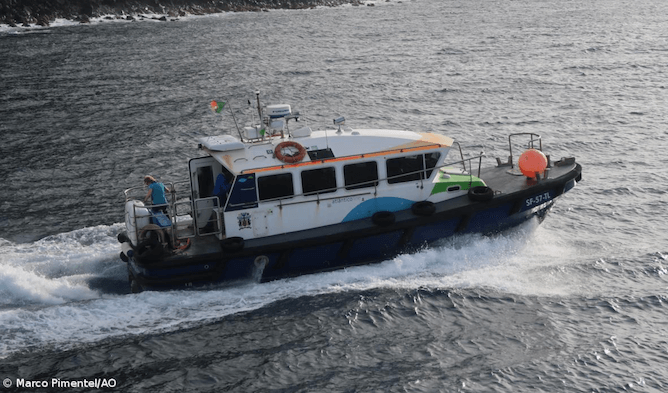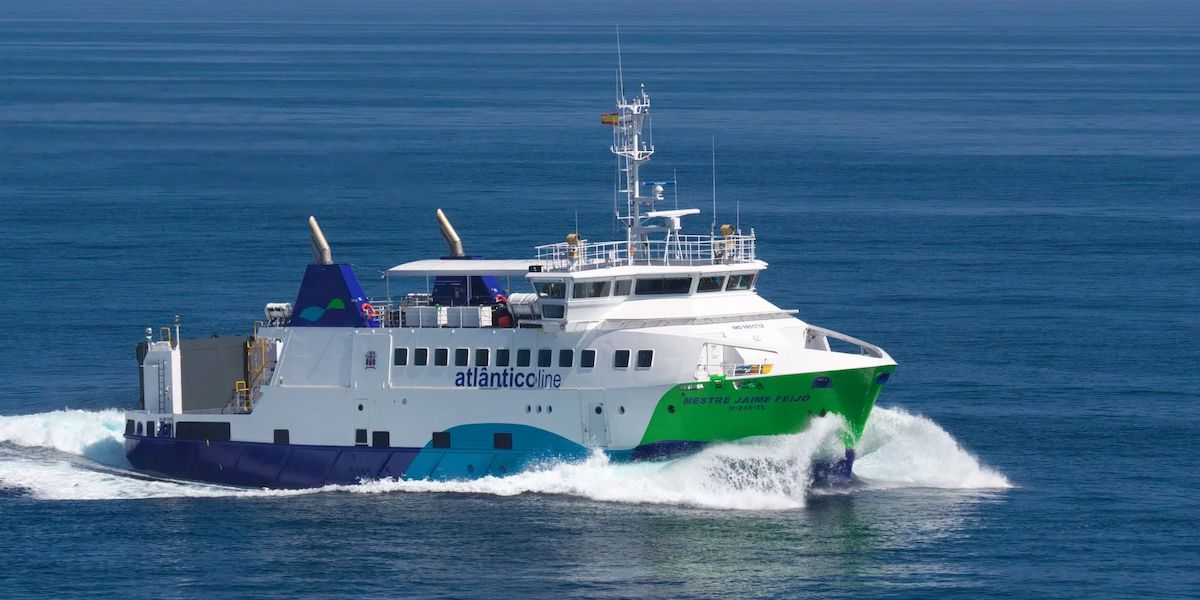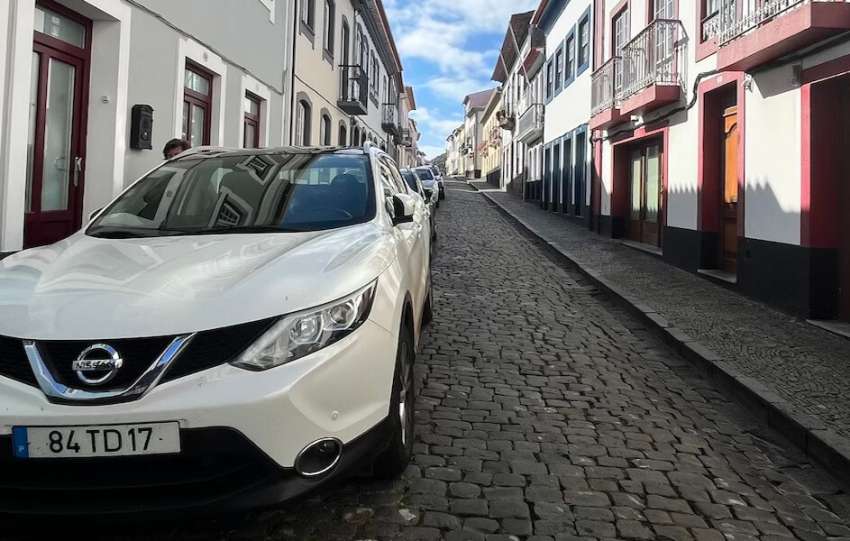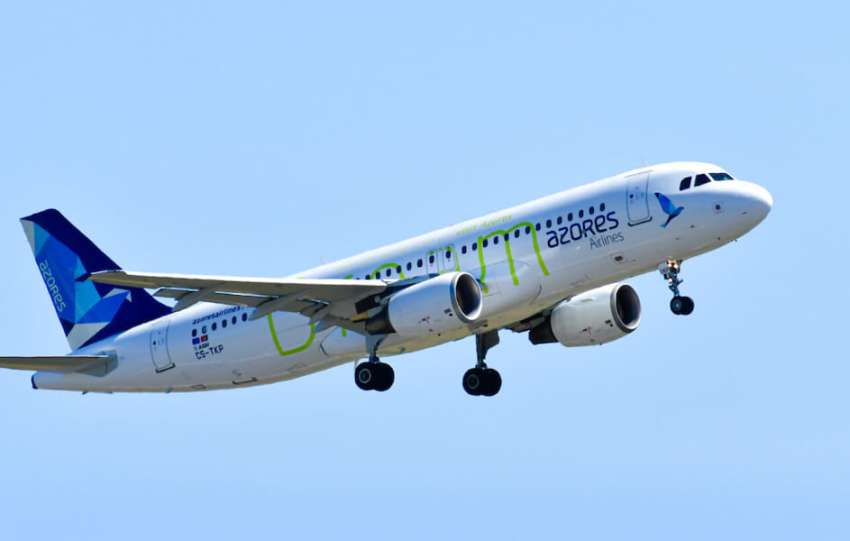Share This Article
Once you arrive in the Azores – most likely in the island of São Miguel or in Terceira -, you will soon realise that one of the best ways to travel in between islands is by using the ferry. And hence this guide to the Azores ferries. But first, let’s shart at the beginning, shall we?
The Azores archipelago
The Azores archipelago consists of 9 islands grouped into three groups:
– The eastern group, made up of the island of São Miguel (the largest and most populated island in the Azores) and the island of Santa Maria, known for being a holiday destination for the people of São Miguel.
– The central group, made up of the triangle islands (São Jorge, Pico and Faial) as well as Terceira and Graciosa island. The islands in the triangle are islands very close to each other, so the short distances that separate them are generally overcome using Azores ferries and not flights.
– The western group, made up of the remote islands of Flores and Corvo. It is the most difficult group to access and where fewer people arrive.
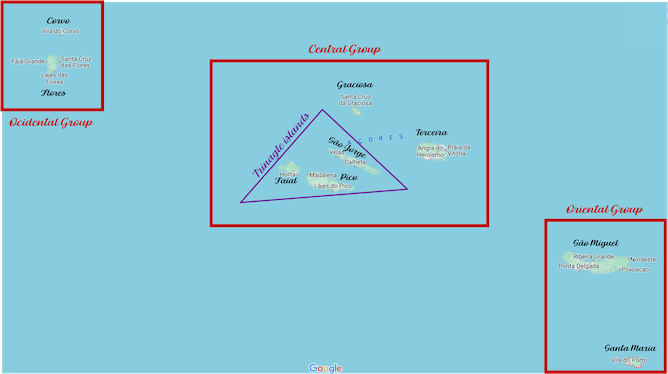
Traditionally, we use planes to travel between different groups of islands and the Azores ferries to travel between islands belonging to the same group.
Thus, there are boats circulating between the islands of Flores and Corvo (in the western group) and between all the islands in the central group, although the most frequent ferries are between the islands in the triangle, because they are islands very close to each other.
We are now going to talk about the ferries’ options.
How to travel between the Azores islands: the Azores ferries
There is only one ferry company in the Azores, Atlântico Line, and it publishes the times and frequencies with no specific frequency (a bit annoying, I know). Sometimes it is once a month, sometimes it publishes a schedule available for the next 2 or 3 months… it’s crazy for organized people who like to schedule everything well in advance, I know!
Connection lines
There are several connection lines. The ones you will probably be using the most are the ones between the triangle islands (Pico, Faial and São Jorge), which are the blue, orange and greens lines, represented on this map:
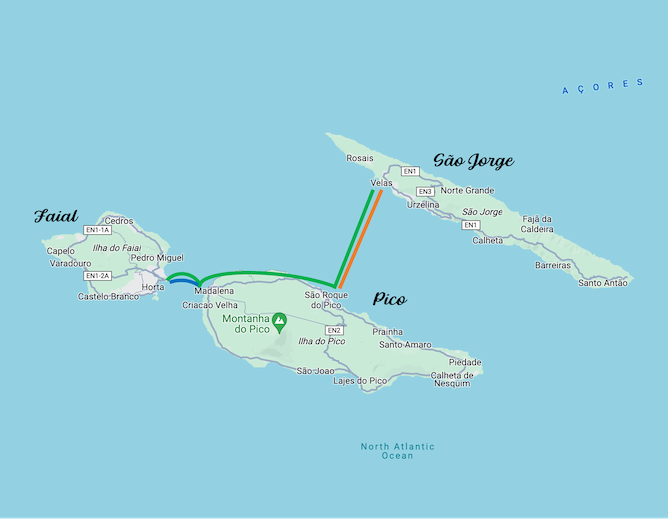
Blue Line: Connection between Horta (in Faial Island) and Madalena (in Pico Island). It is a quick 30-minute ride and you will find multiple routes in either direction per day. In winter the frequency of the blue line is 3 to 4 trips per day, and in summer the frequency doubles.
Green Line: Connection between Horta (Faial), Madalena (Pico) and Velas (São Jorge). In winter, the green line has one trip per day, and on Mondays and Wednesdays there are two trips. In summer there are two guaranteed trips per day, but there are up to 5 trips per day.
Orange Line: Connection between Velas (São Jorge) and São Roque (Pico). Every day except Wednesdays and Thursdays, twice a day. The orange line operates from June 1st to September 30th.
There are two extra lines connecting the most “remote” islands of the central group, Terceira and Graciosa islands:
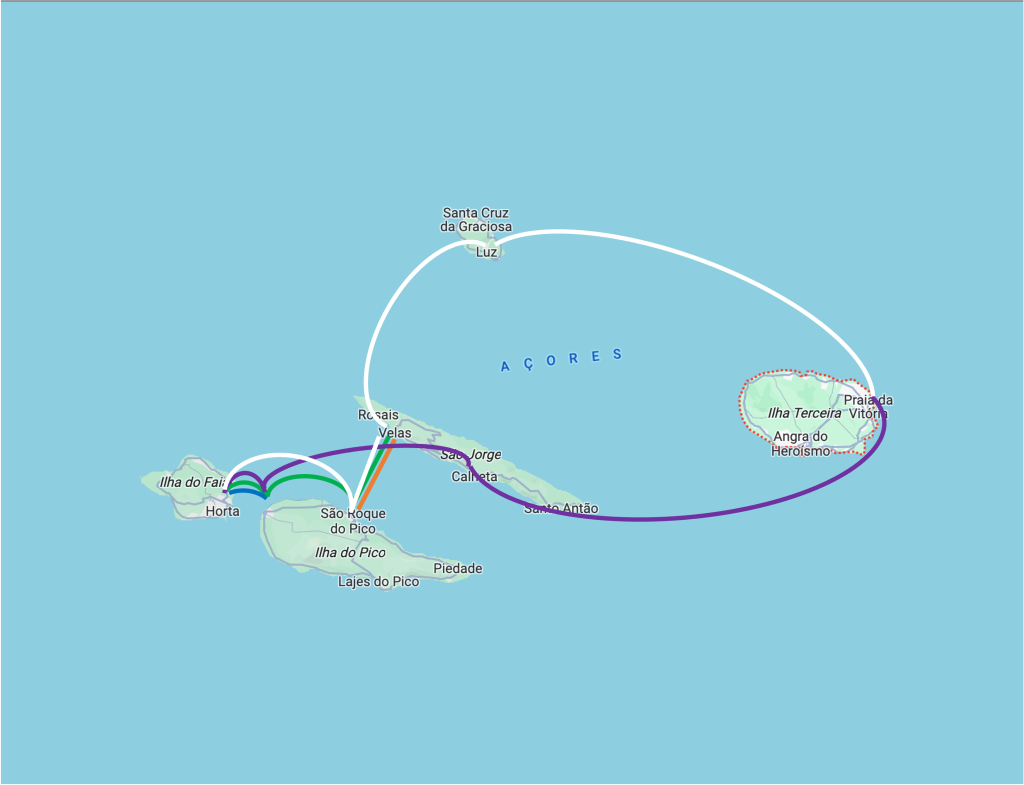
Purple Line: Only on Tuesdays and Saturdays. Connection between the three islands of the triangle (Horta in Faial island, Madalena in Pico island and Calheta in São Jorge island) to Praia da Vitória, in Terceira island. The purple line is a seasonal line that runs from June 1 to September 30, just on Tuesdays and Saturdays.
White Line: Connection between Faial (Horta), Pico (Madalena), São Jorge (Velas), Graciosa (Praia) and Terceira (Praia da Vitória). It is the most complete line of the Azores ferries since it connects all the islands of the central group. Typically, it takes place twice a week, on Monday and Friday, and only during the summer, from June 1st to September 30th.
Pink Line: Connection between Santa Cruz (Flores) and Vila do Corvo (Corvo). Typically a day trip per day (leaves early in the morning and comes back in the late afternoon), even during winter.
The fact that there are all these ferry lines does not mean that they are all active throughout the year! For example, there are understandably far fewer ferry connections during the winter and they are always subject to being canceled if the weather is really bad, which is often the case in winter.
There are currently no ferry connections between São Miguel island and Santa Maria island.
Schedules
Every two months the timetables for each ferry line are published either on the Atlântico Line website or at all piers on all the Azores islands. For example, these were the schedules published in October 2023, for the two following months:
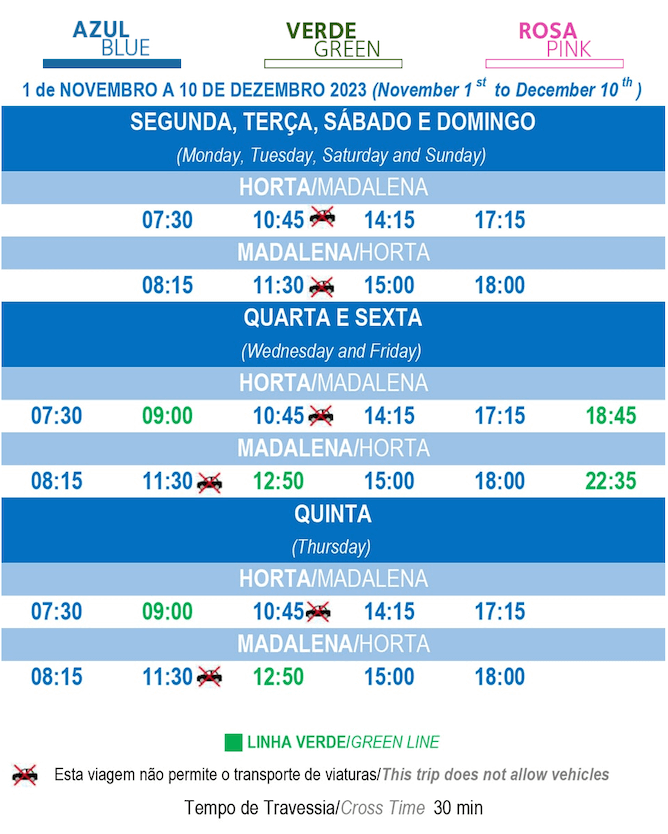
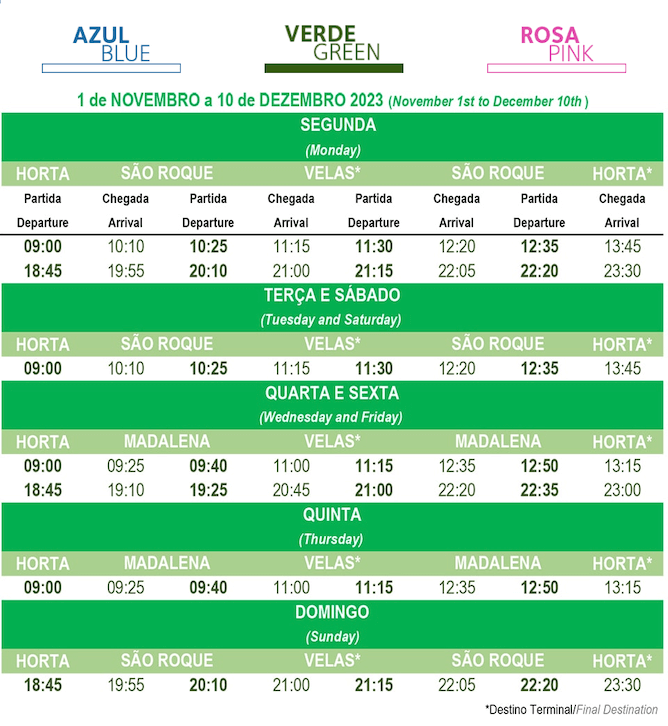
Tickets to the Azores ferries
Prices and trip duration
There are lots of prices depending on your age, starting point and arrival point, etc., but in general, these are the current rates for adults, for the most common trips:
| Starting Point | Ending Point | Duration | Price (€) |
| Horta (Faial island) | Madalena (Pico island) | 25 min | 3,80€ |
| Horta (Faial island) | São Roque (Pico island) | 1h10 | 12,00€ |
| São Roque (Pico island) | Velas (São Jorge island) | 50 minutes | 10,50€ |
| Madalena (Pico island) | Velas (São Jorge island) | 1h20 | 10,50€ |
| Calheta (São Jorge island) | Praia da Vitória (Terceira island) | 3h | 27,50€ |
| Velas (São Jorge island) | Graciosa island | 2h30 | 29,50€ |
| Graciosa island | Praia da Vitória (Terceira island) | 4h | 27,50€ |
| Santa Cruz (Flores island) | Corvo island | 40 min | 10,00€ |
If you are a geek and need to know ALL the prices, then these are the current adults’ tariffs for Azores ferries:
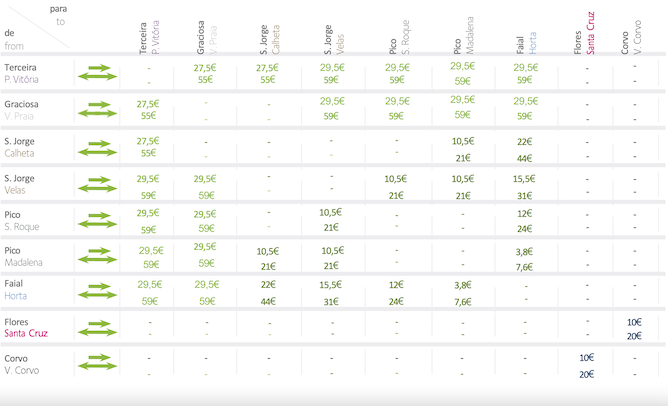
If you are over 65 years old or handicapped, these reduced prices apply:
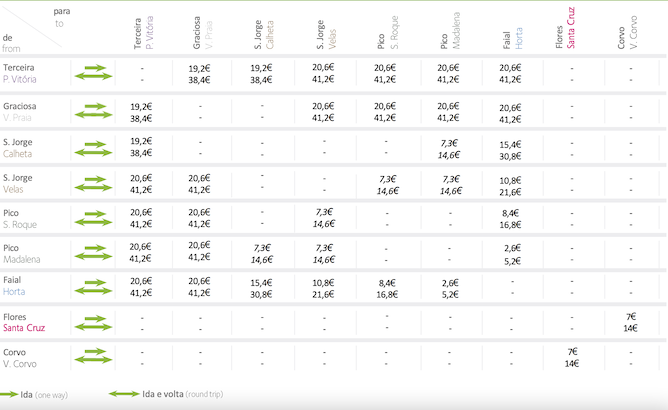
Children between 3 and 12 years old pay half the price of any fare, that is, they pay 50% of the ticket. Babies up to 3 years old do not pay a ticket.
If you plan your trip well and see that you are going to make 4 trips, you may be interested in purchasing the Sea Pass, which costs 60€/adult and 35€/child and entitles you to 4 trips on any route.
What is included on my ticket?
The ticket includes the ticket itself plus two pieces of luggage weighing up to 35 kg. Each extra bag costs €1.50 (you read that correctly, just €1.50 extra!).
How to buy tickets
There are basically three ways to acquire your tickets to the ferries:
- You can buy your ticket at the boarding pier. If you choose this alternative, I recommend that you buy your ticket(s) in advance, and preferably that you also buy the return ticket (if you are going to return to the same island from which you depart) or else that Buy connecting tickets to the following islands now.
- You can also buy your ticket on the Atlântico Line website. In the top right corner there is the word “Booking” written in green. Click there and then just select whether you want a one-way or round trip, departure island and arrival island and travel date. Then, if necessary, you can add a vehicle or extra luggage.
Finally, provide your email address (they ask for more information, but email is really enough) and choose the payment method.
You can choose to pay with a credit or debit card or via ATM or MB Way. These two options only make sense for those who have a Portuguese bank account. As far as I know, it is not yet possible to pay with PayPal.
- You can also buy your ticket on the Atlântico Line app but, to be completely honest, it is rubbish and I never managed to make it work on my iPhone. Perhaps it works better on an Android phone, but I never tried it.
What if I need to cancel my ticket?
If you want to cancel your ticket you have two options. If you purchased it directly from Atlantico Line, call the contact center or go to the ticket office. If you purchased your ticket through a travel agency, you must ask them to take care of canceling your ticket.
What if I need to transport a car between islands?
It is possible to transport vehicles on some ferries, and prices vary according to the vehicle category.
These are the currently existing vehicle categories:
- P1: motorcycles (2 wheels vehicles).
- P2: 4×4, three wheel motorcycles.
- P3: regular vehicles up to 7 seat vans.
- P4: 9 seat van.
These are the prices according to each vehicle category (please keep in mind that this price applies ONLY to the vehicle itself – you also need to buy the ticket to all its passengers!):
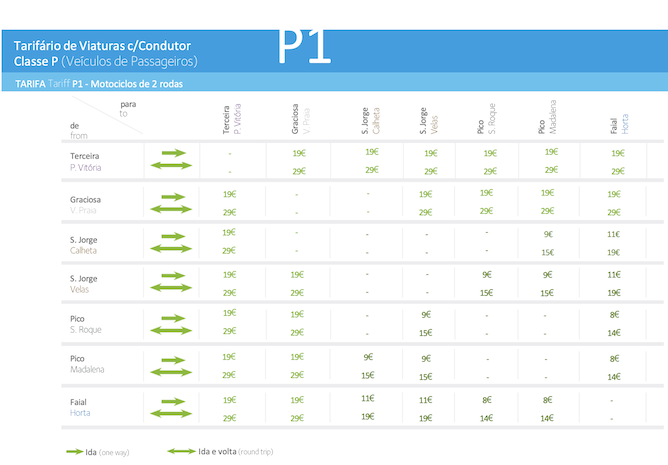
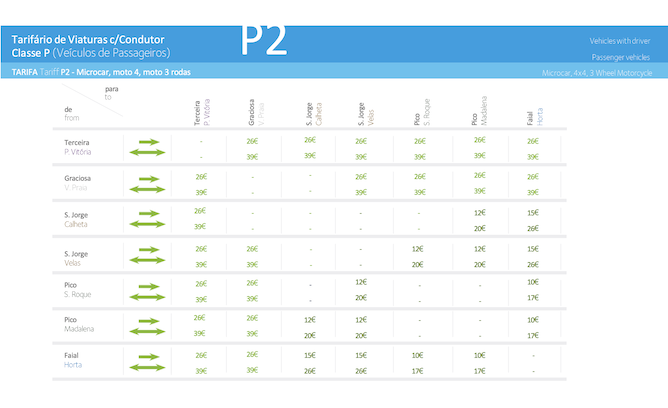
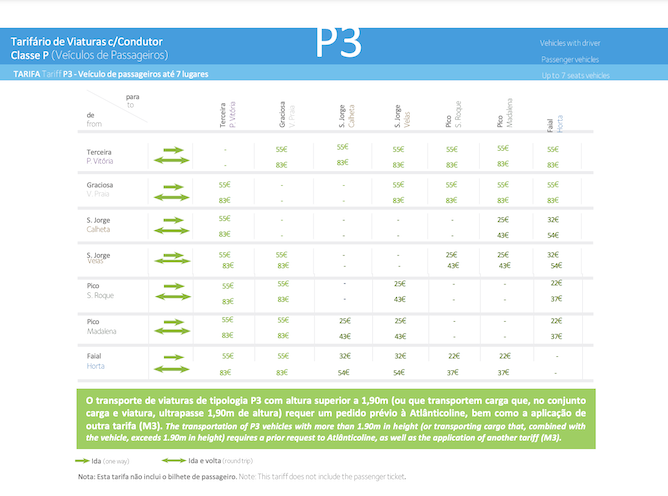
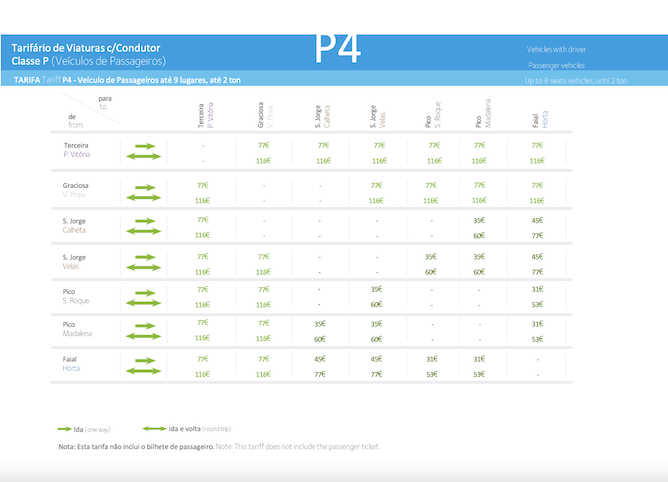
What if I need to transport my pet between islands?
Pets can be transported alone or accompanied by you. Regardless of the option chosen, animals must be transported in a box to be provided by the owner AND they are not allowed to travel inside the ship.
The transport of unaccompanied animals implies a prior request to Atlânticoline (+351292242000 or send an email to comercial@atlanticoline.pt).
These are the prices to transport animals in Azores ferries:
What if the weather is terrible? Is it safe to use the Azores ferries then?
There is something super cool about the Azores ferries which is that their decision to go out to the ocean is never random nor up to an individual.
This means that they have internal metrics that dictate when and if it is safe to take the ferry trip, and if this metric is exceeded (I believe it is when the sea waves exceed 4 meters in height) the boats simply do not go out to sea.
So whenever it is too dangerous to sail, rest assured there will not be a connection, which sucks but ultimately it means that you will always be safe.
Pro tip: In the event of a ferry cancelation, Atlântico Line will make a publication on their facebook page:
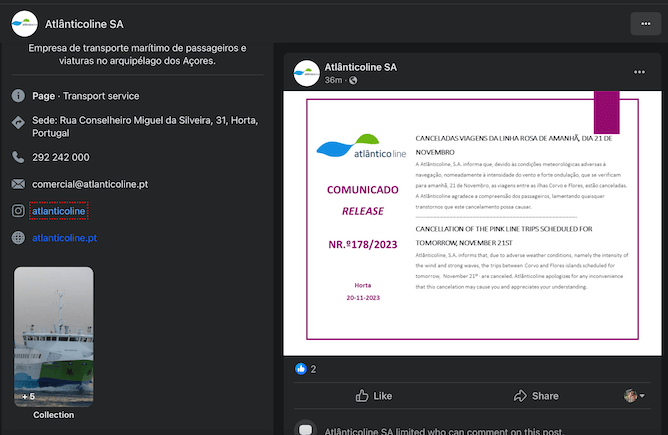
If the trip is cancelled due to bad weather, do I need to go to the pier to change my ticket?
If there is a cancellation due to bad weather, Atlântico Line immediately sends an SMS to the customer notifying them of the cancellation. In any case, they also call the customer to find out what they want to do: reschedule the trip for the next available boat, cancel the ticket, etc.
Please note that Atlântico Line is not responsible for providing transport, accommodation or meals due to cancellations due to bad weather, and it is up to each passenger to do their own due diligence to ensure the continuation of their journey.
Will I get sick on the Azores ferries?
Honestly, that really depends on a) your sensitivity b) on the direction of the waves and c) on how bad the weather is 😛What I can tell you from personal experience is that I ALWAYS get sea sickness when I travel between São Jorge and Faial islands and I have several strategies to handle it. The first strategy and the one that works the best, is to stay outdoors. You can also try to take a sea sickness pill (or whatever they are called) half an hour before boarding the ferry. And don’t forget NOT to eat before you go on a ferry trip! 😀
What do the boats look like?
There are currently 2 car ferries, each 40 meters long. One of these ferries has 296 people and 10 vehicles on board, the other has 333 people and 12 vehicles. Here’s how they look like:

There are also two smaller ferries, both from the 80s, the Cruzeiro do Canal and the Cruzeiro das Ilhas. Each of them has the capacity for 196 people but does not transport vehicles. The Canal Cruise is used on the orange line. The Cruzeiro das Ilhas is used on the blue line to compensate for the days when ferries carrying vehicles are used on the longer lines.
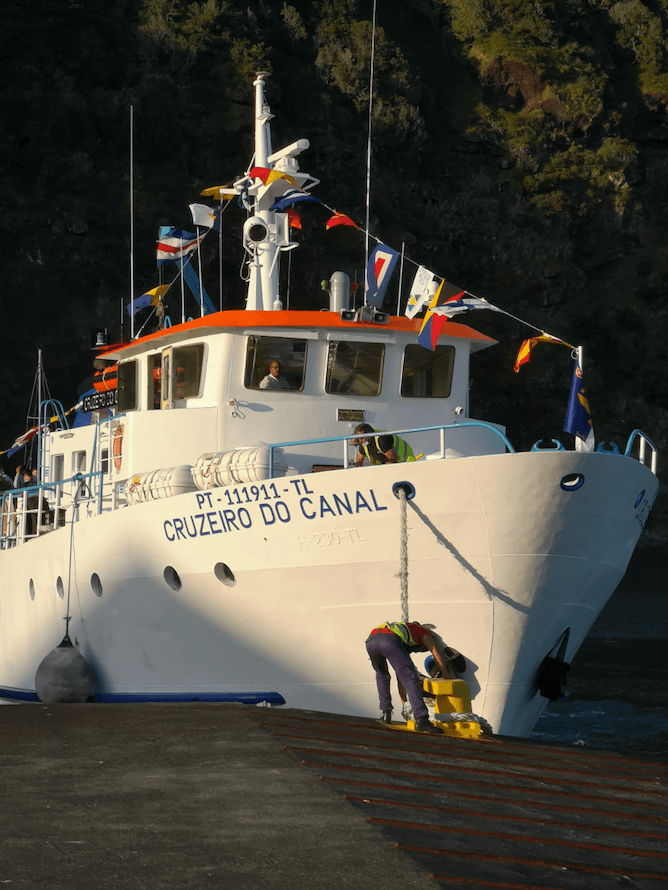
Between the island of Flores and the island of Corvo, the boat Ariel runs, which only takes 12 passengers on board:
